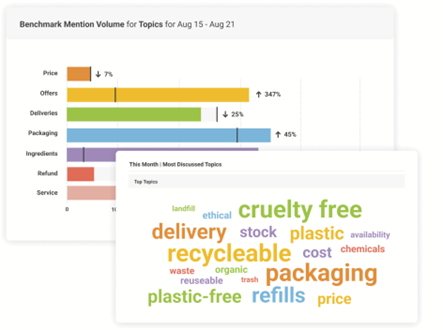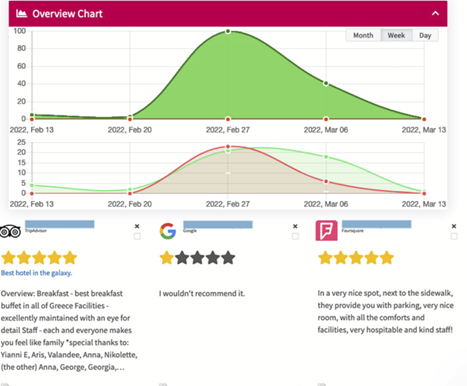Today is easier than ever to spread the word online regarding experiences with different products and services. Just a click of a button. That’s why businesses looking to strive need to keep an eye on such interactions. And here is where brand monitoring enters the scene.
Think of brand monitoring as a sort of guardian of your brand’s reputation. But it’s far more than tracking mentions, it’s about listening to your customers, paying attention to the nuances and answering promptly and authentically to their concerns.
Brand Monitoring Meaning
Brand monitoring is the process of tracking your brand’s online presence and reputation. This includes everything from social media mentions to online reviews, blog posts, news articles, conversations, interactions, and anything in between.
However, it’s not about simple social listening. It’s about compiling valuable insights from your audience’s sayings and feelings about your brand and using that to improve the customers’ experience.
In essence, it’s a complex lookout system for your business’s online footprint. And it offers a complete synopsis of your reputation.
Depending on the scale of your business, brand monitoring can be a time-consuming task, which is why many businesses invest in brand monitoring tools.
Why is brand monitoring important?
In our online world, where the word spreads like fire, there is no business that can ignore what consumers are saying about it and its products.
Thus, monitoring brand mentions becomes a powerful tool that highlights your business’s journey. And it is vital because:
Online conversations may easily snowball. Reviews, mentions, and online interactions are like stones thrown into a lake. The ripples created by the stone spread widely and shape your brand reputation and perception.
Brand monitoring is the instrument that informs you about these ripples and gives you the possibility to intervene and modify their trajectory.
It helps build a loyal audience. Positive experiences, a responsive attitude and prompt resolution of their requests create a sort of connection and a sense of loyalty.
It’s a two-directional connection and creates an evolving link between your brand and your audience.
Since you take into consideration her requirements, sentiments and concerns and take action to respond to her needs. In turn, your audience will reward your brand with her loyalty.
What Are the Benefits of Brand Monitoring?
There are many benefits brand monitoring brings, including:
- Improves customer satisfaction: By tracking what people are saying about your brand online, you can quickly address any negative sentiment and turn unhappy customers into loyal ones.
- Boosts brand awareness: Brand monitoring can help you track your brand’s reach and identify new opportunities for promotion.
- Managing online reputation: In the event of a crisis, it can help you quickly assess the situation and take steps to protect your business’ reputation.
- Offers customer insights. Based on them you have the opportunity to improve your products and services and bring to the scene innovative initiatives.
- Competitor analysis. Knowing in real time what competitors are doing provides valuable information about their challenges and strengths, and reveals new market opportunities.
- Increasing sales: By tracking social media mentions and online reviews, you can identify brand advocates and target them with marketing messages.
Best Practices for Effective Brand Monitoring
To take maximum profit from monitoring your brand presence, consider the following best practices:
Set clear objectives
Define what are you looking to achieve through your brand monitoring activities. Do you need to improve customer satisfaction, to outrank competitors or maybe promptly solve any crisis that might appear?
Your purposes will define your monitoring strategy. Also, it needs to align with your marketing and business strategies in a balanced manner.
Pick metrics that are relevant for your brand to assess performance
Metrics measure the health of your brand from your audience’s perspective.
Gauge the sentiments by analysing comments, mentions, interactions, posts and reviews. Go beyond mere words and dive into the qualitative aspects of sentiment. Determine the context, the tone and real emotions involved in these conversations.
Measure the impact of your brand monitoring efforts. Are they bringing the expected results? Check metrics like conversion rates, customer retention, sales leads, etc.
Select the right monitoring tool for your brand
The core work of the monitoring activity will be done via brand monitoring tools. They gather large amounts of text data, analyse them and extract valuable insights.
Today, you have many options at your disposal to choose from. Make a list of criteria, verify your options and choose the one that fits best your current business needs.
When choosing a tool consider aspects like features, the benefits it brings in for your brand, your budget, whether they are user friendly, do they integrate smoothly with your existing tech infrastructure, whether they are scalable, etc.
What Channels Should You Consider for Brand Mention Monitoring?
The volume of existing data on a plethora of mediums that need to be gathered and analysed is undoubtedly overwhelming. But today we have powerful tools that are capable of processing huge amounts of data.
One such tool is Symanto, an all-in-one insights platform.
You have a great alternative to create and harness your competitive advantage by employing the combined power of psychology and next-gen AI technology. And get highly accurate and in-depth insights to support your business decisions and strategies.
Symanto’s self-service platform is at your disposal to collect all the needed online data. Process and analyse it almost instantly to deliver actionable and advanced brand insights.
Your significant benefits are:
- Access millions of online data points and obtain valuable customer insights.
- Receive top-level opinion analysis personalised for your target audience.
- Enjoy the advantages of a highly accurate sentiment analysis executed at the topic and text level.
- Tailor your analysis model to change rapidly the topics and sentiment in accordance with your niche requirements.
- Leverage psychology AI to uncover unique consumer insights.
- Convert instantly text into business-critical metrics and streamline your business decisions.
Just test it, it’s free and see what results you obtain.
As already indicated, no matter what brand monitoring tool you choose it should be capable of overviewing as many data sources as possible.
Some of them are:
All social media channels where your brand is present
Social media monitoring is the core task of brand monitoring. Customers lately use social networks to share their feedback, complaints or compliments.
Hence, social listening is an absolute must. But, it’s more than tracking, it’s mainly about interaction, as it shows your business’s commitment towards its audience.
Also, monitor the influencers that you can partner with to expand your reach.
Online news media
Paying attention to professional bloggers in your industry and journalists’ opinions about your brand is noteworthy. As they can have a huge influence.
Just imagine what benefits would be for your brand if you were positively featured in a world-renowned media venue.
Review websites
Monitoring your brand reviews on aggregators like Google Reviews, Amazon, AppStore, or TrustPilot is a pertinent way of identifying your service/product weaknesses and strengths.
Build your brand reputation and show excellence in your customer support to improve customer experience and convert detractors into loyal clients.
Online forums
Using forum-style platforms like Reddit and Quora for brand mention monitoring is a smart strategy.
Be active and answer all questions related to your brand and other questions linked to your niche, where you have something meaningful to say. It’s also a way to enhance your marketing strategy.
What Elements Should You Monitor?
It’s not enough to know the channels that need to be surveilled, but also what you have to monitor.
Here are some key elements that you should constantly oversee:
Product and brand names
Obviously, your brand name is the first thing to monitor. You will be informed when discussions including your brand develop online.
Next in line are your product/service names, blog names, nicknames, and acronyms. And their alternatives and even incorrect spelling versions. Also, consider tracking your marketing campaign names, if you have.
Here is a brand monitoring example, when the brand promptly answered the client’s mention:

Source: Instagram
Industry terms
Keeping an eye on industry-related conversations and trends helps your business stay updated with the latest news and innovations. And as a consequence, maintain your offering relevancy.
Tracking the pulse of perception allows you to better understand your audience’s sentiment and also to detect patterns and trends that might not have been observed otherwise.
Plus, make the necessary decisions to take measures in due time when significant modifications appear.
Competitors
Monitoring your competition is a way of knowing exactly what’s your position on the market.
Usually, the tools for brand monitoring propose a competitor analysis that presents insights into direct competitors’ strategies and their market approaches.
Management staff and other public figures associated with the brand
Your monitoring strategy should also include monitoring the persons associated with your brand, be it management staff, investors or other prominent stakeholders. Because the perception of the respective person may extend towards your brand.
Sentiment analysis
Including sentiment analysis in your brand monitoring approach is a wise decision. As it allows you to earn highly accurate and in-depth insights into your audience’s feelings and emotions.
It can go beyond words and take into consideration tones and context. And detect the nuances of human language with accuracy. But it’s still critical to involve human judgement in the process to get the best results.
Best Brand Monitoring Tools
Symanto
Symanto is a powerful AI-driven text analysis solution that helps you scan your brand via the customers’ lens and surface hidden insights to elaborate an effective marketing strategy.
Measure your brand performance against that of competitors. Employ tested and pre-defined frameworks, and qualitative and quantitative metrics to evaluate your brand.
If you face issues with:
- Finding the reasons why your brand loyalty is low.
- Identifying why some business areas perform better or underperform in comparison with the competition.
- The lack of tools to improve brand engagement.
Symanto has the right solution for you. With our technology, you can:
- Gather review data that really matters and relevant social mentions.
- Assess your audience’s emotional connection with your brand and compare it with similar cases of your competitors.
- Monitor noteworthy customer conversations.
- Employ emotional and functional equity as important criteria for your brand health.
- Conceive a strong marketing strategy backed by data.
Symanto’s brand health-related features are:
- Competitor benchmarking – Evaluate your major KPIs and compare them with those of the competition.
- Brand share of meaningful conversations – Work only with clean data, remove duplicates, spam, noise, and irrelevant mentions.
- Comprehensive data collection – Monitor all data points available online.
- Functional equity – Identify your products that attract the most emotions towards the brand.
- Emotional equity – Gauge the customer’s experience aspects that influence their emotional experience.
What makes our approach unique is blending social analytics with market research. Resulting in highly accurate, granular insights extracted from customer opinions, almost instantly and at scale.
In a word, you obtain a valuable evaluation of your brand health and get actionable and hidden insights in real time.
Curious to see what Symanto can do for your business? Just send us a message.
Brandwatch

Brandwatch is a customer intelligence tool covering several aspects of marketing from content marketing to social media management, influencer marketing and stakeholder administration.
It is a complex tool, comprising an array of valuable features like:
- Brand management. Efficient and extensive brand monitoring to identify opportunities to expand your brand.
- Crisis management. Spot potential crises in the early stages, act promptly and protect your brand reputation.
- Market research. Keep an eye on how the market evolves, on consumers’ requirements and how these modify in time.
- Customer care.
- Content marketing.
- Social media management.
- Stakeholder management.
- Influencer marketing.
Their technology is centered on consumer research. To enhance the performance some valuable add-ons were conceived. These are Reviews, Consumer Research and Vizia (visual reporting app).
Mentionlytics

Mentionlytics offers a monitoring solution aiming to track all online mentions related to your business. Including comments and remarks about your services, products, competitors, etc.
Plus other social media listening and management capabilities. Accompanied by a Social Intelligence Advisor(SIA) conceived to deliver actionable insights and recommendations to boost your brand.
The Mentionlytics platform proposes features like:
- Social Listening. Discover meaningful aspects related to your customers, what really matters to them, what makes the difference and what makes them act and buy.
- Media Monitoring. Stay in the loop and know in due time what the media says about your brand.
- Review Monitoring. Get a complete panorama of your brand presence by tracking all the reviews you receive. Answer them and any other complaints that might appear to build trust around your brand.
- Social Intelligence.
- Social Media Report Builder.
- Publishing.
Crisis Management and Real-Time Engagement
Brand monitoring has multiple benefits, but one of the most significant is crisis management.
It can be the compass that drives you out of a stormy situation. And is the radar that helps:
Spot issues in time and answer proactively to negative mentions
Negative sentiments are somehow similar to small sparks, if they are not extinguished in due time, they can easily degenerate into large fires.
Brand monitoring is the antidote to that, allowing you to identify problems early and address them right away.
Embrace negative sentiments and criticism, and notice the opportunities they bring. Use empathy and transparency to answer them.
Manage crisis
Famous crisis management stories usually are the effect of leveraging the benefits of real-time monitoring.
For example, if an airline that experienced flight delays acts rapidly and addresses the situation via social media. Their passengers will turn from frustration to consideration or even admiration.
Brand monitoring has also an active role in prevention. Sentiment and trend analysis help anticipate potential crises and create plans of action before the situation evolves for the worse.
Brand Monitoring Trends for the Future
In a fast-paced economic environment, keeping up with the competition involves being aware of emerging trends.
Let’s look at the top trends changing the landscape of brand monitoring software:
Advanced natural language processing
One of the most exciting advancements in brand monitoring is the development of cutting-edge natural language processing (NLP) capabilities.
Natural language processing is a form of artificial intelligence that enables computers to understand human language.
This is a significant development for brand monitoring because it can help you automate many manual tasks involved in tracking your brand’s online presence.
For example, NLP can be used to automatically identify and categorise social media mentions, track sentiment, and generate reports.
NLP is powered by machine learning, which means it’s constantly evolving and getting more accurate.
Sentiment analysis technology has long struggled to interpret nuances, misspellings and slang. But NLP output now is much more accurate at understanding the context of online conversations.
Psychographics
Another exciting trend in brand monitoring is the use of psychographics. Psychographics is the study of personality traits, deep values, attitudes and interests.
It’s often used in marketing to segment audiences and target them with more personalised messaging, but it can also be employed in brand monitoring.
Find out what kind of people are following your brand. Are you reaching your desired audience? How does your audience compare with your main competitors? You can find the answers to these questions using psychographic technology.
Brand monitoring tools are now offering this kind of data, which can give you a much deeper understanding of your brand’s online presence.
Symanto offers two different research-based psychographic models using the most prevalent personality taxonomies: the Myers-Briggs Type Indicator (MBTI), based on Carl Jung’s personality theory and The Big Five (OCEAN) model.
Combined with Symanto’s advanced sentiment analysis, these models can also give you insights into the proportion of customers that demonstrate an emotional connection to your brand. And are most likely to remain loyal, as well as “at-risk” customers who are most likely to churn.
Alerts
Monitoring tools are used by PR and marketing teams to help them track media coverage, and act quickly before negative sentiment escalates into a PR disaster.
One popular feature in brand monitoring software is alerts. Alerts allow you to get real-time notifications whenever your brand or a topic relating to your brand is mentioned online.
This feature is particularly useful for small to medium-sized businesses operating within a niche market, but larger businesses can be overwhelmed by the noise.
In these situations, you need more specific alerts, for example, you can set up alerts to notify you only on negative brand mentions.
You can also choose to receive alerts for competitor brand mentions or for industry-related news. Some brand monitoring tools will also allow you to track specific keywords related to your brand.
Enhanced security
Any time you introduce new technology to your business, especially if it handles customer data, digital security is of utmost importance.
When it comes to brand monitoring, security is two-fold: you need to protect your brand’s online presence from malicious attacks, and you need to ensure that the data collected by monitoring tools is secure.
Some of the newer brand monitoring tools on the market offer enhanced security features, such as two-factor authentication and end-to-end encryption.
For example, when it comes to data security, GDPR compliance is a must for any brand monitoring tool that handles EU citizens’ data. The General Data Protection Regulation (GDPR) is a regulation in the EU in the area of data protection that was put into effect in 2018.
It puts special limits on how you can use and store personal identification data. Make sure any tech you introduce is GDPR compliant and is committed to using the most advanced digital security technology for secure data handling.
Reporting and data-visualisation
Since today we have to handle loads of data, effective reporting and visualisation are vital.
Businesses want tools that provide them with clean dashboards, visually appealing and concise. So, they can easily depict and interpret complex insights and outcomes.
Omni-Channel Integration
Since customers use a variety of platforms, brand monitoring is required to gather and correlate data from multiple touch-points. Social media channels, websites, news sites, review sites, chatbots, customer care, etc.
There you have a comprehensive guide about brand monitoring that arms you with the necessary knowledge to get the most out of this activity. So, go ahead, harness its power, shape perceptions and build strong brand loyalty.

